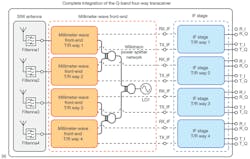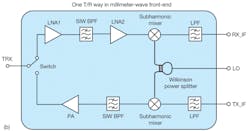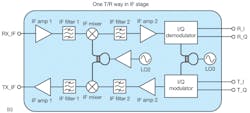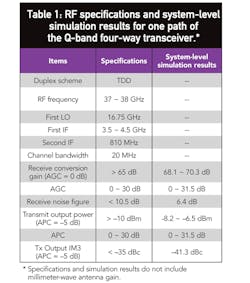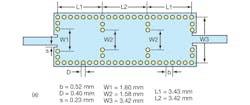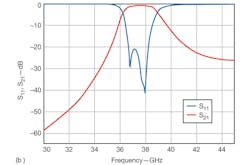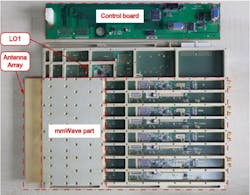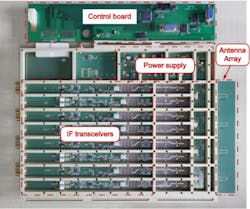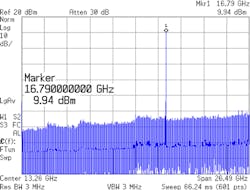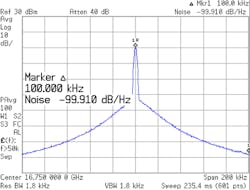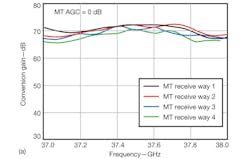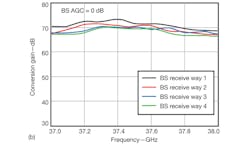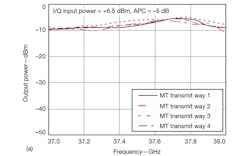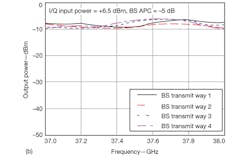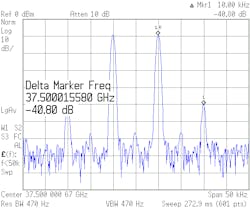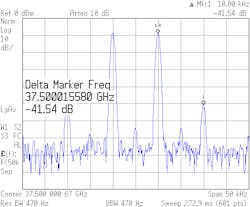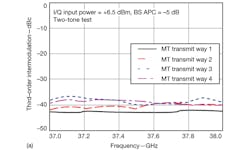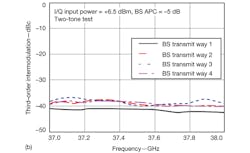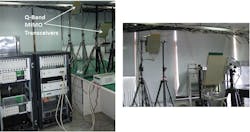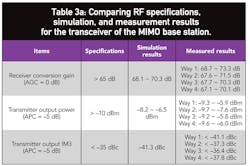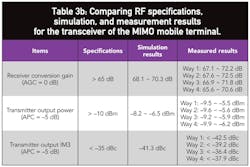Q-Band Transceiver Makes MIMO Links
Millimeter-wave frequencies offer generous available bandwidth for next-generation wireless communications, provided that practical transmit and receive hardware can be developed. To that end, a low-cost, broadband, and miniature four-way transceiver has been designed for use at Q-band for multiple-input, multiple-output (MIMO) applications. Suitable for short-range, high-date-rate wireless communications from 37 to 38 GHz, the four-way transceiver has been fabricated on a single multilayer printed-circuit board (PCB) that integrates four-way antennas, radio front ends, and intermediate-frequency (IF) stages.
Large appetites for high data rates have driven advances in communications, including the use of MIMO systems with their potential to provide multiple independent transmission channels and achieve very high spectral efficiencies.1 With many other advanced techniques—including high-level modulation (QPSK or higher level) and orthogonal frequency division multiplexing (OFDM) techniques—a MIMO system can greatly increase channel capacity,2-8 making it an attractive solution for next-generation wireless applications that require high throughput with limited bandwidth.
Related Articles
• Conquer Testing Of IEEE 802.11ac MIMO
• Analyzer Checks MIMO To 26.5 GHz
• PXI Vector Analyzer Tackles MIMO
Crowding of applications at lower frequency bands has made those bands overcrowded and subjected to interference. Since the millimeter-wave range (above 30 GHz) offers a great deal more clean bandwidth, it is an attractive alternative for next-generation indoor and outdoor broadband wireless applications.9,10 In China, the millimeter wave communication standard “Q-LINKPAN” was proposed in 2010 by Professor Wei Hong and his group, and the working frequency band will be at Q-band. However, to the best of the authors’ knowledge, a low-cost, multiway RF transceiver designed for MIMO wireless communications at Q-band frequencies has not yet been reported.
The four-way transceiver four Q-band MIMO wireless communications reported here is based on a research project between Southeast University (China) and The Boeing Co. The RF frequency band for the transceiver spans 37 to 38 GHz, within the atmospheric attenuation window suitable for millimeter-wave transmissions. After careful design and optimization, a pair of single-board integrated Q-band four-way transceivers were fabricated and characterized, and the transceivers were also successfully applied in a Q-band 4 × 4 MIMO wireless communication system.
Figure 1 shows a block-diagram of the Q-band four-way transceiver. It consists of three main parts: the antenna, the millimeter-wave front end [Figs. 1(b) and 1(d)], and the intermediate-frequency (IF) stage [Fig. 1(c)]. Normally, it is necessary to ensure uncorrelated fading characteristics for the wireless channel of a MIMO communication system for proper operation. Thus, the adjacent antenna elements of the wireless system should have a substantial spacing of at least one-half wavelength,2-6 which is about 3.95 to 4.05 mm for signals at 37 to 38 GHz.
In the design of the transceiver system, the distance between the adjacent antenna is set to be 45 mm (more than five wavelengths for the carrier frequency), which minimizes the coupling between two adjacent antennas. For sharper impedance bandwidth and transmission characteristics, substrate-integrated-waveguide (SIW) filtennas11 are used in the transceivers. The SIW technique is low in cost, compatible with the printed-circuit-board (PCB) process being used, and supports ease of integration for the entire transceiver. Meanwhile, the surface of the SIW can be directly connected to the metallic shielding wall, facilitating excellent electromagnetic (EM) shielding from outside interference.12 Through the integration of the SIW filtenna with the millimeter-wave front-end, the cable loss between them can also be avoided—a loss which is otherwise considerable at Q-band frequencies.
1. These block diagrams show (a) the full four-way Q-band transceiver with integrated antennas and IF stage; (b) one transmit/receive (T/R) path in the millimeter-wave front-end section; (c) one T/R path in the IF section; and (d) a simple block diagram representing local oscillator LO1.
The 4 × 4 MIMO system utilizing the four-way transceiver is designed for indoor/on-board short range use. The Q-band four-way transceiver employs a classic superheterodyne architecture with time-division-duplex (TDD) scheme. One view of the schematic diagram for the transceiver front-end is shown in Fig. 1(b). Table 1 provides the required RF/microwave specifications for the transceiver design.
Due to the parasitic effects of the surface-mount-technology (SMT) package, the RF performance of conventional SMT components will seriously deteriorate at Q-band frequencies. Thus, all the active components in the millimeter-wave front-end are monolithic-microwave integrated circuits (MMICs) without SMT packages, which are carefully mounted to the PCB circuits through wire-bonding. GaAs low noise amplifiers (LNAs), model XL1000 from Mimix Broadband (now M/A-COM Technology Solutions), with 18-dB gain and 2.2-dB noise figure at 38 GHz, provide good low-noise performance and reasonable gain to suppress the noise of the following transceiver stages.
Given the application scenarios (indoor/on-board short range use), a GaAs medium power amplifier XB1005-BD is employed at the transmitter end. For frequency upconversion and downconversion, subharmonic mixer model HMC339 from Hittite Microwave Corp. was used to simplify LO1, which is comprised of an X-band oscillator and a frequency doubler, as shown in Fig. 1(d). Filters with high selectivity are necessary to suppress the subharmonic and harmonic signals from LO1.
2. The diagram shows (a) the geometry of the SIW filter while (b) the S-parameter plots show the simulated S11 and S21 responses for the SIW filter.
An SIW-type filter was chosen for the millimeter-wave image-rejection filter, owing to the excellent performance and small size achievable with this type of filter design at Q-band frequencies. Detailed design information for the filter can be found in ref. 13, and the dimensions of the SIW filter can be obtained with the formulas presented in that report. The filter was simulated with the HFSS three-dimensional (3D) electromagnetic (EM) simulation software from Ansys for analysis and design improvements, as shown in Fig. 2. The filter and the transceiver were simulated and fabricated on TLY circuit laminate from Taconic. The circuit material has a thickness of 0.254 mm and relative dielectric constant, εr, of 2.2 in the z-axis at 10 GHz.
Figure 1(c) offers a schematic diagram of the transceiver’s IF stage. The first IF amplifier is carefully designed with a GaAs high-electron-mobility-transistor (HEMT) model MGF4921AM device from Mitsubishi Electric, with 12-dB linear gain and 1.5-dB noise figure. A wideband triple-balanced mixer is used for frequency upconversion and downconversion. For high-linearity application, the mixer demands +13 dBm local-oscillator (LO) pump power. A driver after the LO2 output is needed. In order to select different signal channels for each T/R path (each signal channel uses 20-MHz bandwidth), the IF-stage employs an independent LO2. The automatic gain control (AGC) and automatic power control (APC) are achieved by means of variable-gain IF amplifier2, resulting in a dynamic range of 30 dB at 810 MHz for both the transmitter and receiver in the IF stage.
System-level simulation of one transmit-receive path of the transceiver was performed with the Advanced Design System (ADS) 2009 simulation software from Agilent Technologies. The simulation results are presented in Table 1 with adequate margin. A high-frequency, multilayer printed-circuit-board (PCB) material was used to integrate the antenna, millimeter-wave front end, and IF stage onto one assembly. Use of the board made it possible to realize the Q-band, four-way transceiver as a low-cost, miniature design.
(a)
(b)
3. These photographs offer (a) a top view of the four-way transceiver and control board and (b) a bottom view of the transceiver and control board.
Since the four-way transceiver integrates the SIW antennas, millimeter-wave front-ends, and IF-stages on one PCB, signals from Q-band to IQ baseband exist on the same board, and steps must be taken to minimize cross coupling and interference. Parallel ground viaholes are used to control the crosstalk of microstrip lines on the PCB board.14 Meanwhile, metal framework was used to isolate different function blocks, helping to suppress cross coupling and shield environment interference and provide protection for the MMIC devices. Figure 3 shows the construction of the Q-band, four-way transceiver, and control board.
(a)
(b)
4. These spectral plots show (a) the measured output spectrum of LO1 and (b) the measured phase noise for LO1 offset 100 kHz from the carrier.
To evaluate the performance of the transceiver, a pair of the Q-band designs were implemented for 4 × 4 MIMO base stations and MIMO mobile terminals. Table 2 provides a summary of measured results for key blocks of the transceiver, while Fig. 4 depicts the measurement results for local oscillator LO1. The oscillator’s subharmonic and harmonic levels are effectively suppressed by the SIW bandpass filter. After compensation for cable loss, the LO1 output power is found to be +14.1 dBm at 16.75 GHz; its phase noise is -99 dBc/Hz offset 100 kHz from the carrier.
Figure 5 presents the measured results of the receiver conversion gain for the transceiver portions of the of MIMO mobile terminal and base station. The receiver conversion gain does not include gain from the antenna. The automatic gain control (AGC) can vary from 0 to -31.5 dB, and was set to 0 dB as the test condition. From the measured results, the conversion gain was found to fluctuate within 5.1 dB for the 1-GHz bandwidth from about 37 to 38 GHz.
5. These plots of conversion gain show the transceiver in the (a) MIMO MT application and (b) in the MIMO BS application.
6. These plots of output power show the transceiver in the (a) MIMO MT application and (b) in the MIMO BS application.
Figure 6 shows the measured results for the transmit output power of the MIMO mobile terminal and base station transceiver. The automatic power control (APC) was set to -5 dB as the test condition, and the baseband I/Q signal input power was +6.5 dBm. Under those same test conditions, the third-order intermodulation distortion (IM3) for the transmitter was measured and plotted in Fig. 7 for two tones separated by 10 kHz at 37.5 GHz. Figure 8 shows measurements for the four transmit signals in a 1-GHz bandwidth, with Fig. 8(a) representing the MIMO mobile terminal and Fig. 8(b) being the MIMO base station. Table 3 gives the detailed comparison of the required RF specifications, simulation results, and measured results for the transceiver of MIMO base station and MIMO mobile terminal. Figure 9 shows how the Q-band millimeter-wave multiway transceiver has been successfully applied in an indoor 4 × 4 MIMO wireless transmission system.
(a)
(b)
7. The third-order intermodulation (IM3) distortion was measured at 37.5 GHz with two tones separated by 10 kHz for the transceiver’s path 2 at work in the (a) MIMO MT and in (b) the MIMO BS (with input power of +6.5 dBm and APC at -5 dB).
8. These plots show the measured IM3 distortion for the four-way transceiver used for a (a) MIMO MT and (b) a MIMO BS.
9. These photographs show the installed Q-band 4 × 4 MIMO wireless communication system.
The Q-band four-way transceivers described in this report were fabricated on low-cost, multilayer PCB material, demonstrating their potential as a practical solution for high-data-rate communications at 37 to 38 GHz. Not only did the millimeter-wave transceiver provide measured results that met expectations, it is also functioning as part of a real-world indoor 4 × 4 MIMO wireless transmission system.
Zhe Chen, Engineer
Fang Zhu, Engineer
Wei Hong, Engineer
Jixin Chen, Engineer
Chen Yu, Engineer
Jianyi Zhou, Engineer
Haiming Wang, Engineer
Nianzu Zhang, Engineer
Guangqi Yang, Engineer
Hui Zhang, Engineer
State Key Laboratory of Millimeter Waves, School of Information Science and Engineering, Southeast University, Nanjing 210096, People’s Republic of China, e-mail: [email protected], [email protected].
References
1. J. Thanysen and K. B. Jakobsen, “Checking capacity for MIMO configurations,” Microwaves & RF, Vol. 46, No. 6, pp. 74-82, 2007.
2. A.J. Paulraj, D.A. Gore, R.U. Nabar, and H.Boelcskei, “An Overview of MIMO Communications—A Key to Gigabit Wireless,” Proceedings of the IEEE, Vol. 92, 2004, pp. 198-218.
3. J. Browne, “Measuring MIMO Performance Levels,” Microwaves & RF, Vol. 49, No. 7, 2010, p. 102.
4. Z.Q. Yu, J.Y. Zhou, J.N. Zhao, T. Zhao, and W. Hong, “Design of a Broadband MIMO RF Transmitter for Next-Generation Wireless Communication Systems,” Microwave Journal, 2010, pp. 22-26.
5. A. Kalis, A.G. Kanatas, and C.B. Papadias, “A Novel Approach to MIMO Transmission Using a Single RF Front End,” IEEE Journal of Selected Areas Communications, Vol. 6, 2008, pp. 972-980.
6. D.S. Baum, D. Gore, R. Nabar, S. Panchanathan, K.V.S. Hari, V. Erceg, and A.J. Paulraj, “Measurement and Characterization of Broadband MIMO Fixed Wireless Channels at 2.5 GHz,” in Proceedings of IEEE International Conference on Personal Wireless Communications, 2000, pp. 203-206.
7. K. Yu, M. Bengtsson, B. Ottersten, D. McNamara, P. Karlsson, and M. Beach, “Second Order Statistics of NLOS Indoor MIMO Channels Based on 5.2 GHz Measurements,” in Proceedings of IEEE GLOBECOM ’01, 2001, pp. 156-160.
8. J.W. Wallace, M.A. Jensen, A.L. Swindelhurst, and B.J. Jeffs, “Experimental Characterization of the MIMO Wireless Channel: Data Acquisition and Analysis,” IEEE Transactions On Wireless Communications, 2003, pp. 335-343.
9. S.K. Yong and C.C. Chong, “An Overview of Multigigabit Wireless Through Millimeter Wave Technology: Potentials and Technical Challenges,” EURASIP Journal of Wireless Communications, 2007, pp. 50-50.
V. Dyadyuk, O. Sevimli, J. Bunton, J. Pathikulangara, and L. Stokes, “A 6 Gbps Millimeter Wave Wireless Link With 2.4 bit/Hz Spectral Efficiency,” IEEE MTT-S International Microwave Symposium Digest, 2007, pp. 471-474.
11. C. Yu and W. Hong, “37-38 GHz Substrate Integrated Filtenna for Wireless Communication Application,” Microwave and Optical Technology Letters, 2012, pp. 346-351.
12. C. Yu, W. Hong, and Z.Q. Kuai, "Substrate Integrated Printed Dipole Array Antenna for Isolation the RF Front-end From The Antenna,” Microwave and Optical Technology Letters, 2009, pp. 557-562.
13. Z.C. Hao, W. Hong, H. Li, H. Zhang, and K. Wu, “A Broadband Substrate Integrated Waveguide (SIW) Filter,” IEEE International Symposium on Antennas and Progress, 2005, pp. 598-601.
14. F.C. Xiao, K. Murano, and Y. Kami, “The Use of Via Holes for Controlling The Crosstalk of Nonparallel Microstrip Lines on PCBs,” IEEE International Symposium on Electromagnetic Compatibility (EMC 2002), Vol. 8, 2002, pp. 633-638.

